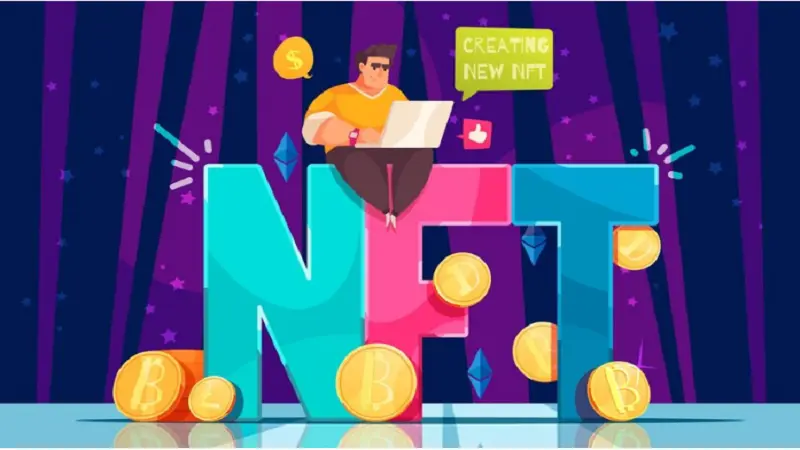Non-fungible tokens (NFTs) have become one of the most nft february octoberirwindecrypt talked-about innovations in the digital world over the past few years. From their emergence to their current status, the trajectory of NFTs has been marked by rapid evolution, diverse applications, and significant market shifts. This article delves into the journey of NFTs from February to October, examining the key developments, trends, and impacts during this period.
Understanding NFTs
Before delving into the specifics of the February to October timeline, it’s essential to have a foundational understanding of what NFTs are. Non-fungible tokens are unique digital assets verified using blockchain technology, most commonly the Ethereum blockchain. Unlike cryptocurrencies such as Bitcoin or Ethereum, which are fungible and can be exchanged on a one-to-one basis, NFTs are unique and cannot be exchanged on a like-for-like basis. Each NFT has distinct information or attributes that set it apart from others.
NFTs can represent a wide array of digital and physical assets, including art, music, virtual real estate, collectibles, and more. They have gained prominence for their ability to create verifiable ownership and provenance for digital goods, something that was previously challenging to establish in the digital realm.
February: The Rise of NFT Awareness
Market Expansion
In February, NFTs were experiencing a significant surge in mainstream awareness. This period marked a peak in media coverage and public interest, driven by high-profile sales and celebrity endorsements. One of the most notable events was the record-breaking sale of Beeple’s digital artwork “Everyday: The First 5000 Days” for $69.3 million at Christie’s auction house. This sale not only highlighted the value of digital art but also brought NFTs into the limelight of global conversations.
Technological and Platform Developments
During this time, several platforms were crucial in supporting the NFT ecosystem. OpenSea, Rarible, and Foundation were among the prominent NFT marketplaces facilitating trades and auctions. These platforms were continually enhancing their functionalities, adding features like enhanced search capabilities, improved user interfaces, and better integration with digital wallets.
In addition to marketplace advancements, there were notable technological improvements. Layer-2 scaling solutions, such as Optimistic Rollups and zk-Rollups, began to address Ethereum’s scalability issues, which had been a significant concern due to the high gas fees associated with NFT transactions.
March to May: Market Dynamics and Trends
Diverse Applications and Collaborations
The months following February saw a diversification in NFT applications. Beyond digital art, NFTs began to gain traction in various sectors, including gaming, sports, and music. Gaming companies like Axie Infinity and Decentraland showcased how NFTs could be used for virtual assets and real estate, while sports organizations and athletes explored NFTs for fan engagement and collectibles.
Collaborations between traditional brands and NFT creators also became prevalent. High-fashion brands like Gucci and Prada explored NFT drops as part of their digital strategy, merging the physical and virtual worlds. This period highlighted the versatility of NFTs in bridging different industries and audiences.
Regulatory Scrutiny and Market Corrections
As the popularity of NFTs surged, so did scrutiny from regulators. Discussions about the regulatory framework for digital assets became more pronounced, with various jurisdictions beginning to draft guidelines and regulations for NFTs. Concerns over intellectual property rights, tax implications, and financial regulations were among the key issues being addressed.
The NFT market also experienced some corrections during this period. After the nft february octoberirwindecrypt initial hype, there was a noticeable decrease in the astronomical prices of some NFTs, leading to a recalibration of market values. This correction was partly due to market saturation and the natural ebb and flow of speculative investments.
June to August: Evolution and Innovation
Emergence of New Standards
By mid-year, new standards and protocols began to emerge, aiming to enhance the functionality and interoperability of NFTs. The ERC-721 and ERC-1155 standards, which define how NFTs are created and managed on the Ethereum blockchain, continued to evolve. Additionally, new standards like ERC-20 for fungible tokens and ERC-998 for composable tokens gained traction, offering greater flexibility in the creation and management of NFTs.
Community and Social Impact
NFTs also began to play a more significant role in community-building and social impact initiatives. Projects like “CryptoPunks” and “Bored Ape Yacht Club” not only provided unique digital assets but also fostered vibrant online communities. These communities often organized events, collaborations, and charitable initiatives, demonstrating the potential of NFTs to create social value beyond their financial worth.
Social impact was further exemplified by projects that used NFT sales to support charitable causes. For instance, artists and creators began allocating a portion of their NFT sale proceeds to philanthropic efforts, amplifying the positive impact of the NFT ecosystem.
September to October: Consolidation and Future Prospects
Institutional Adoption and Integration
As the year progressed towards September and October, institutional adoption of NFTs became more pronounced. Major corporations and financial institutions began exploring NFTs for various use cases, including digital identity verification, loyalty programs, and tokenized assets. Companies like Visa and Mastercard announced their intentions to integrate NFT technology into their services, signaling a growing acceptance of NFTs in the financial sector.
Market Maturity and Long-Term Outlook
By October, the NFT market was showing signs of maturation. The initial speculative frenzy had given way to a more measured and strategic approach. Investors and creators were focusing on the long-term value and utility of NFTs, moving away from purely speculative investments. The emphasis shifted towards nft february octoberirwindecrypt creating sustainable and meaningful digital assets with intrinsic value.
The development of new use cases and applications continued to drive innovation. Virtual reality (VR) and augmented reality (AR) integrations began to gain traction, offering immersive experiences that combined NFTs with interactive digital environments. Additionally, advancements in cross-chain interoperability aimed to expand the NFT ecosystem beyond the Ethereum blockchain, potentially increasing accessibility and reducing costs.
Conclusion
The period from February to October showcased the dynamic and evolving nature of the NFT space. From groundbreaking sales and technological advancements to market corrections and institutional adoption, NFTs have demonstrated their potential to reshape various industries. As the NFT ecosystem continues to develop, the focus is likely to shift towards creating lasting value and integrating NFTs into nft february octoberirwindecrypt broader technological and economic frameworks.
The journey of NFTs from their initial surge in popularity to their current state reflects a broader trend of digital transformation and innovation. As we move forward, the continued exploration of NFTs’ potential will be pivotal in defining their role in the digital landscape.


